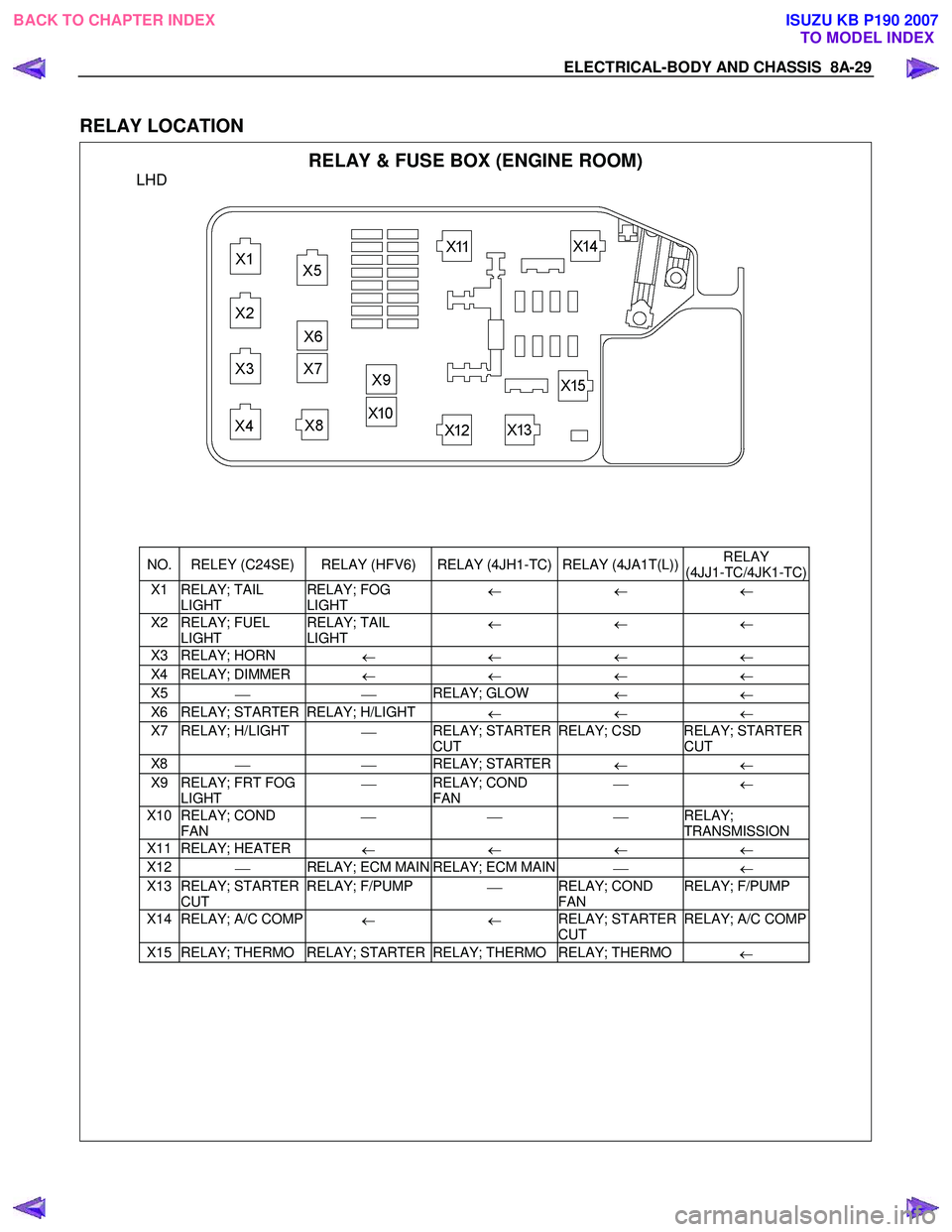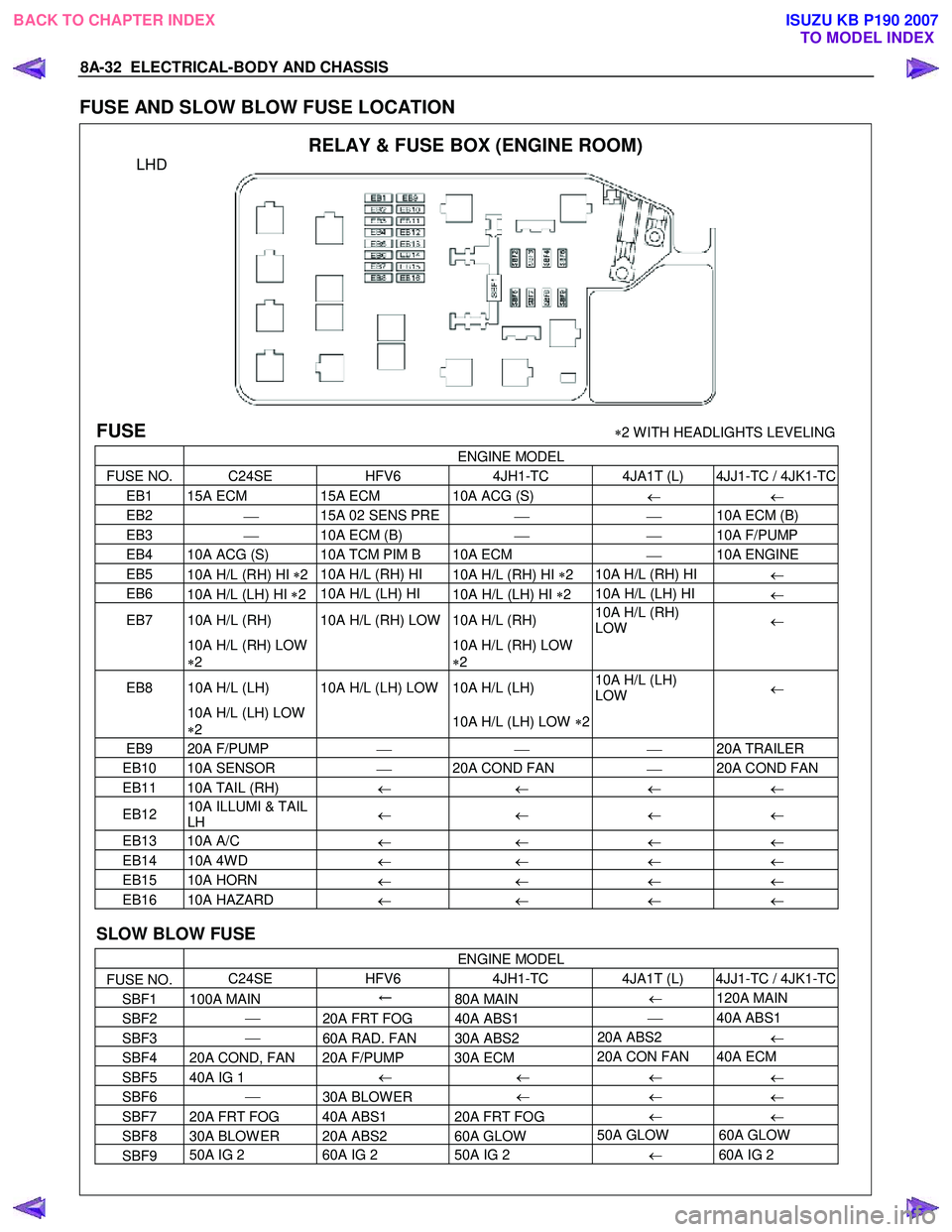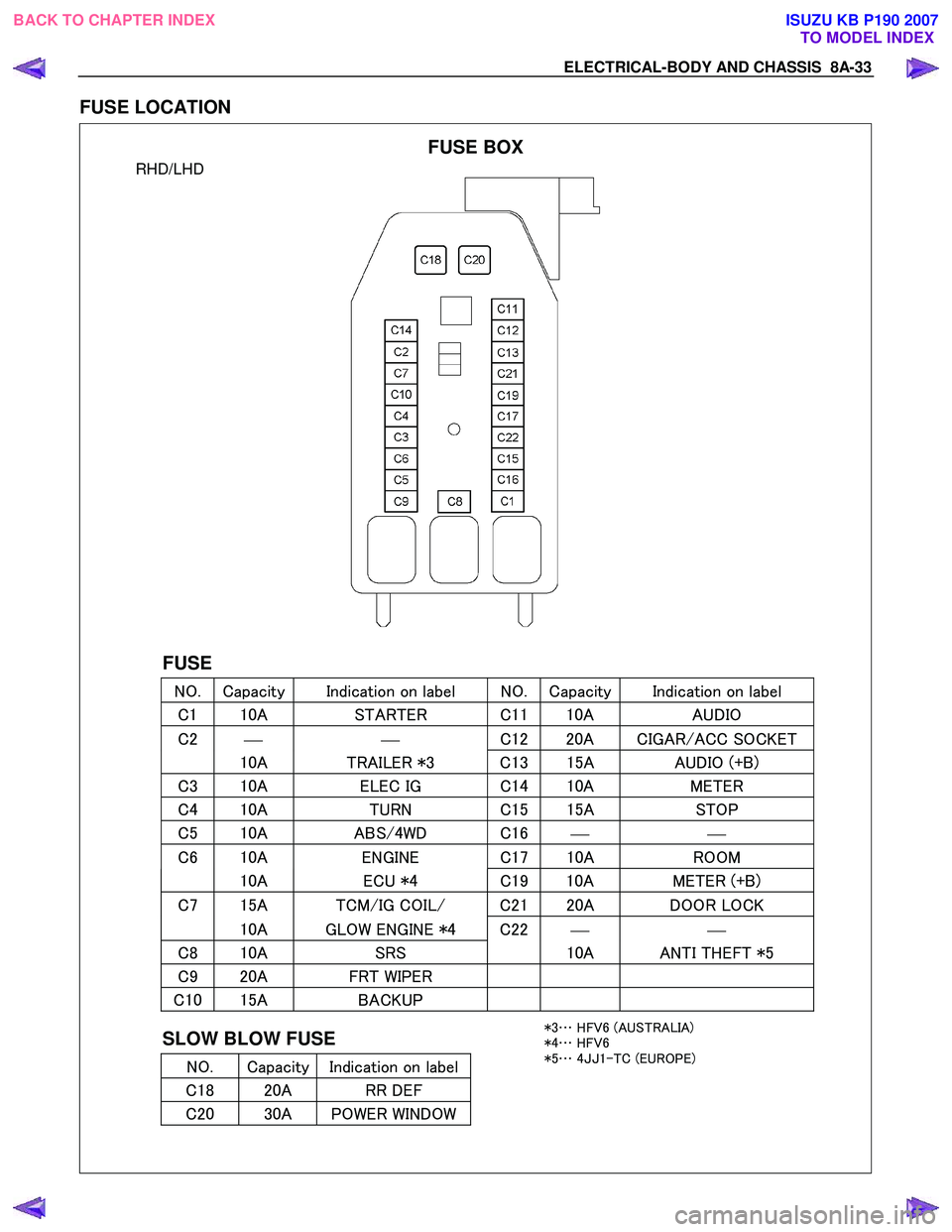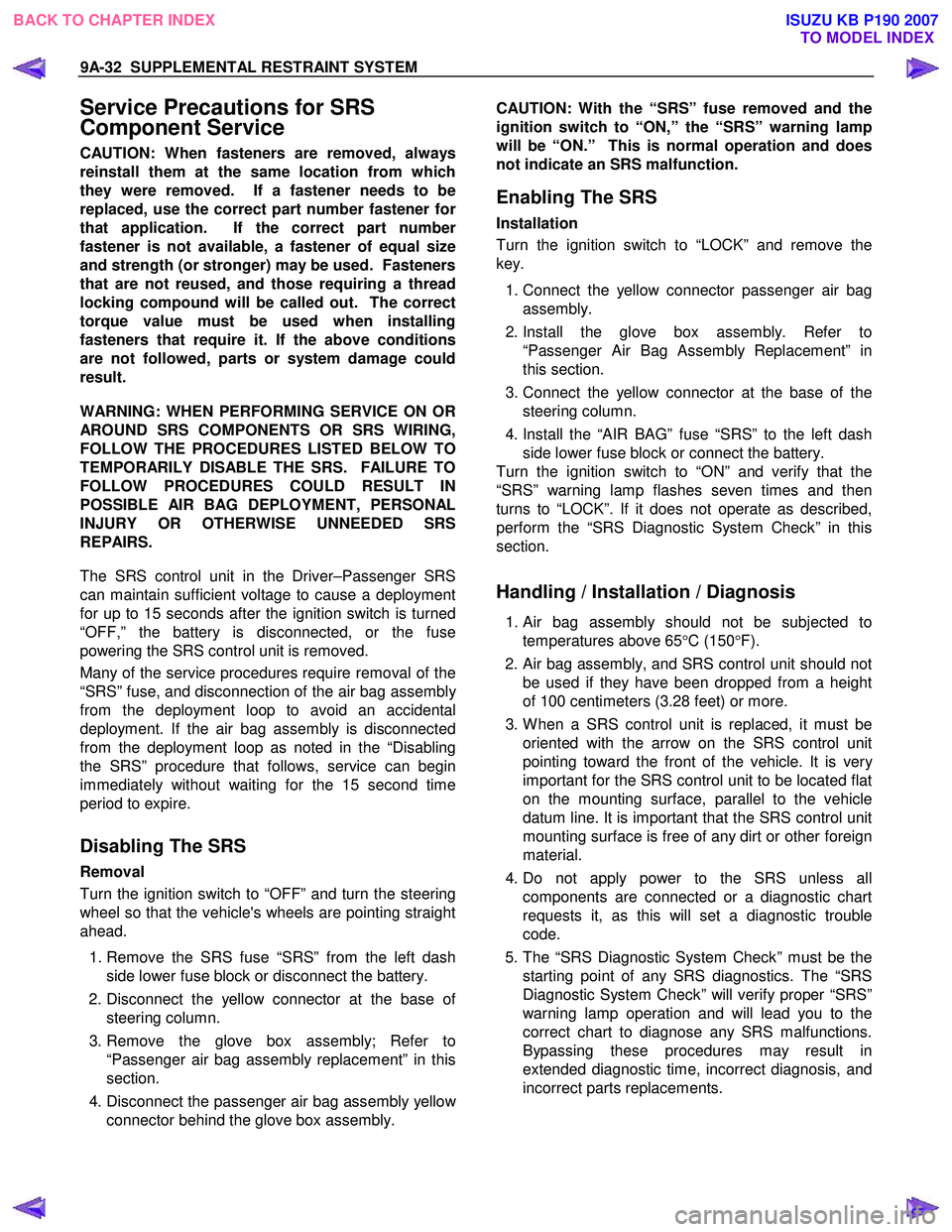fuse box location ISUZU KB P190 2007 Workshop User Guide
[x] Cancel search | Manufacturer: ISUZU, Model Year: 2007, Model line: KB P190, Model: ISUZU KB P190 2007Pages: 6020, PDF Size: 70.23 MB
Page 4967 of 6020

ELECTRICAL-BODY AND CHASSIS 8A-29
RELAY LOCATION
RELAY & FUSE BOX (ENGINE ROOM)
LHD
NO. RELEY (C24SE) RELAY (HFV6) RELAY (4JH1-TC) RELAY (4JA1T(L)) RELAY
(4JJ1-TC/4JK1-TC)
X1 RELAY; TAIL LIGHT RELAY; FOG
LIGHT ←
← ←
X2 RELAY; FUEL
LIGHT RELAY; TAIL
LIGHT ←
← ←
X3 RELAY; HORN
← ← ← ←
X4 RELAY; DIMMER
← ← ← ←
X5
RELAY; GLOW
← ←
X6 RELAY; STARTER RELAY; H/LIGHT
← ← ←
X7 RELAY; H/LIGHT
RELAY; STARTER
CUT RELAY; CSD RELAY; STARTER
CUT
X8 RELAY; STARTER
← ←
X9 RELAY; FRT FOG
LIGHT
RELAY; COND
FAN
←
X10 RELAY; COND
FAN
RELAY;
TRANSMISSION
X11 RELAY; HEATER ← ← ← ←
X12
RELAY; ECM MAIN RELAY; ECM MAIN
←
X13 RELAY; STARTER
CUT RELAY; F/PUMP
RELAY; COND
FAN RELAY; F/PUMP
X14 RELAY; A/C COMP
← ← RELAY; STARTER
CUT RELAY; A/C COMP
X15 RELAY; THERMO RELAY; STARTER RELAY; THERMO RELAY; THERMO
←
BACK TO CHAPTER INDEXTO MODEL INDEXISUZU KB P190 2007
Page 4968 of 6020

8A-30 ELECTRICAL-BODY AND CHASSIS
RELAY LOCATION
RELAY & FUSE BOX (CABIN)
RELAY
Connector No. B7 B8 B40
Relay name
REAR DEFOGGER POW ER W INDOW (NO RELAY)
BACK TO CHAPTER INDEX
TO MODEL INDEXISUZU KB P190 2007
Page 4969 of 6020

ELECTRICAL-BODY AND CHASSIS 8A-31
FUSE AND SLOW BLOW FUSE LOCATION
RELAY & FUSE BOX (ENGINE ROOM)
RHD
FUSE ∗1 AUSTRALIA
ENGINE MODEL
FUSE NO. C24SE
HFV6 4JA1T (L) 4JJ1-TC/ 4JK1-TC
EB1 15A ECM
← 10A ACG (S)
←
EB2
15A 02 SENS PRE
10A ECM (B)
EB3 15A FRT FOG 10A ECM (B)
10A F/PUMP
20A TRAILER ∗1
EB4 10A ACG (S)
10A TCM PIM B
10A ENGINE
EB5 10A ILLUMI
10A H/L (RH) HI
← ←
10A H/L (RH) HI ∗1
EB6 10A H/L (LH) HI
← ← ←
EB7 10A H/L (RH) LOW
← ← ←
EB8 10A H/L (LH) LOW
← ← ←
EB9 20A F/PUMP 20A TRAILER
20A TRAIKER
EB10 10A SENSOR 20A COND, FAN
EB11 10A TAIL (RH)
← ← ←
EB12 10A ILLUMI & TAIL-LH
← ← ←
EB13 10A A/C
← ← ←
EB14 10A 4W D
← ← ←
EB15 10A HORN
← ← ←
EB16 10A HAZARD
← ← ←
SLOW BLOW FUSE
ENGINE MODEL
FUSE NO. C24SE
HFV6 4JA1T (L) 4JJ1-TC / 4JK1-TC
SBF1 100A MAIN ←
80A MAIN 120A MAIN
SBF2
20A FRT FOG
40A ABS1 ←
SBF3
60A RAD. FAN
20A ABS2 ←
SBF4 20A COND, FAN 20A F/PUMP
20A COND, FAN 40A ECM
SBF5 40A IG 1
←
← ←
SBF6
30A BLOW ER ←
←
SBF7 20A FRT FOG
40A ABS1 20A FRT FOG ←
SBF8 30A BLOW ER
20A ABS2 50A GLOW 60A GLOW
SBF9
50A IG 2
60A IG 2 50A IG 2 60A IG 2
BACK TO CHAPTER INDEX TO MODEL INDEXISUZU KB P190 2007
Page 4970 of 6020

8A-32 ELECTRICAL-BODY AND CHASSIS
FUSE AND SLOW BLOW FUSE LOCATION
RELAY & FUSE BOX (ENGINE ROOM)
LHD
FUSE ∗2 W ITH HEADLIGHTS LEVELING
ENGINE MODEL
FUSE NO. C24SE HFV6 4JH1-TC 4JA1T (L) 4JJ1-TC / 4JK1-TC
EB1 15A ECM 15A ECM 10A ACG (S)
← ←
EB2
15A 02 SENS PRE
10A ECM (B)
EB3
10A ECM (B)
10A F/PUMP
EB4 10A ACG (S) 10A TCM PIM B 10A ECM
10A ENGINE
EB5
10A H/L (RH) HI ∗2 10A H/L (RH) HI
10A H/L (RH) HI ∗2 10A H/L (RH) HI
←
EB6
10A H/L (LH) HI ∗2 10A H/L (LH) HI
10A H/L (LH) HI ∗2 10A H/L (LH) HI
←
EB7 10A H/L (RH) 10A H/L (RH) LOW 10A H/L (RH) 10A H/L (RH)
LOW ←
10A H/L (RH) LOW
∗ 2
10A H/L (RH) LOW
∗ 2
EB8 10A H/L (LH) 10A H/L (LH) LOW 10A H/L (LH)
10A H/L (LH)
LOW ←
10A H/L (LH) LOW
∗ 2
10A H/L (LH) LOW ∗2
EB9 20A F/PUMP
20A TRAILER
EB10 10A SENSOR
20A COND FAN
20A COND FAN
EB11 10A TAIL (RH)
← ← ← ←
EB12 10A ILLUMI & TAIL
LH ←
← ← ←
EB13 10A A/C
← ← ← ←
EB14 10A 4W D
← ← ← ←
EB15 10A HORN
← ← ← ←
EB16 10A HAZARD
← ← ← ←
SLOW BLOW FUSE
ENGINE MODEL
FUSE NO. C24SE
HFV6 4JH1-TC 4JA1T (L) 4JJ1-TC / 4JK1-TC
SBF1 100A MAIN ←
80A MAIN ←
120A MAIN
SBF2
20A FRT FOG 40A ABS1
40A ABS1
SBF3
60A RAD. FAN 30A ABS2 20A ABS2
←
SBF4 20A COND, FAN 20A F/PUMP 30A ECM 20A CON FAN 40A ECM
SBF5 40A IG 1
←
← ←
←
SBF6
30A BLOW ER ←
←
←
SBF7 20A FRT FOG 40A ABS1 20A FRT FOG ←
←
SBF8 30A BLOW ER 20A ABS2 60A GLOW 50A GLOW 60A GLOW
SBF9 50A IG 2
60A IG 2 50A IG 2
← 60A IG 2
BACK TO CHAPTER INDEX
TO MODEL INDEXISUZU KB P190 2007
Page 4971 of 6020

ELECTRICAL-BODY AND CHASSIS 8A-33
FUSE LOCATION
RHD/LHD
FUSE
NO. Capacity Indication on label NO. Capacity Indication on label
C 1 10A STARTER C 1110A AUDIO
C2
C
12 20A CIGAR/ACC SOCKET
10A TRAILER *3 C 13 15A AUDIO (+B)
C3 10A ELEC IG C 14 10A METER
C4 10A TURN C 15 15A STOP
C5 10A ABS/4WD C 16
C6 10A ENGINE C 17 10A ROOM
10A ECU *4 C19 10A METER (+B)
C7 15A TCM/IG COIL/ C2 120A DOOR LOCK
10A GLOW ENGINE *4 C22
C8 10A SRS 10A ANTI THEFT *5
C9 20A FRT WIPER
C10 15A BACKUP
SLOW BLOW FUSE
NO. Capacity Indication on label
C 18 20A RR DEF
C20 30A POWER WINDOW
FUSE BOX
*3 … HFV6 (AUSTRALIA)
*4 … HFV6
*5 … 4JJ 1-TC (EUROPE)
BACK TO CHAPTER INDEX
TO MODEL INDEXISUZU KB P190 2007
Page 4972 of 6020

8A-34 ELECTRICAL-BODY AND CHASSIS
DIODE LOCATION
RELAY & FUSE BOX
DIODE
C24SE HFV6 4JH1-TC4JA1T (L) 4JJ1-TC/4JK1-TC
No. RHD LHD RHD LHD LHD RHD LHD RHD LHD
X16 ― ― DIODE VSV FICD DIODE
X17 ― ― ― ― DIODE
BACK TO CHAPTER INDEX TO MODEL INDEXISUZU KB P190 2007
Page 5667 of 6020

9A-32 SUPPLEMENTAL RESTRAINT SYSTEM
Service Precautions for SRS
Component Service
CAUTION: When fasteners are removed, always
reinstall them at the same location from which
they were removed. If a fastener needs to be
replaced, use the correct part number fastener fo
r
that application. If the correct part number
fastener is not available, a fastener of equal size
and strength (or stronger) may be used. Fasteners
that are not reused, and those requiring a thread
locking compound will be called out. The correct
torque value must be used when installing
fasteners that require it. If the above conditions
are not followed, parts or system damage could
result.
WARNING: WHEN PERFORMING SERVICE ON OR
AROUND SRS COMPONENTS OR SRS WIRING,
FOLLOW THE PROCEDURES LISTED BELOW TO
TEMPORARILY DISABLE THE SRS. FAILURE TO
FOLLOW PROCEDURES COULD RESULT IN
POSSIBLE AIR BAG DEPLOYMENT, PERSONAL
INJURY OR OTHERWISE UNNEEDED SRS
REPAIRS.
The SRS control unit in the Driver–Passenger SRS
can maintain sufficient voltage to cause a deployment
for up to 15 seconds after the ignition switch is turned
“OFF,” the battery is disconnected, or the fuse
powering the SRS control unit is removed.
Many of the service procedures require removal of the
“SRS” fuse, and disconnection of the air bag assembl
y
from the deployment loop to avoid an accidental
deployment. If the air bag assembly is disconnected
from the deployment loop as noted in the “Disabling
the SRS” procedure that follows, service can begin
immediately without waiting for the 15 second time
period to expire.
Disabling The SRS
Removal
Turn the ignition switch to “OFF” and turn the steering
wheel so that the vehicle's wheels are pointing straight
ahead.
1. Remove the SRS fuse “SRS” from the left dash side lower fuse block or disconnect the battery.
2. Disconnect the yellow connector at the base o
f
steering column.
3. Remove the glove box assembly; Refer to “Passenger air bag assembly replacement” in this
section.
4. Disconnect the passenger air bag assembly yello
w
connector behind the glove box assembly.
CAUTION: With the “SRS” fuse removed and the
ignition switch to “ON,” the “SRS” warning lamp
will be “ON.” This is normal operation and does
not indicate an SRS malfunction.
Enabling The SRS
Installation
Turn the ignition switch to “LOCK” and remove the
key.
1. Connect the yellow connector passenger air bag assembly.
2. Install the glove box assembly. Refer to “Passenger Air Bag Assembly Replacement” in
this section.
3. Connect the yellow connector at the base of the steering column.
4. Install the “AIR BAG” fuse “SRS” to the left dash side lower fuse block or connect the battery.
Turn the ignition switch to “ON” and verify that the
“SRS” warning lamp flashes seven times and then
turns to “LOCK”. If it does not operate as described,
perform the “SRS Diagnostic System Check” in this
section.
Handling / Installation / Diagnosis
1. Air bag assembly should not be subjected to
temperatures above 65 °C (150 °F).
2.
Air bag assembly, and SRS control unit should not
be used if they have been dropped from a height
of 100 centimeters (3.28 feet) or more.
3. W hen a SRS control unit is replaced, it must be oriented with the arrow on the SRS control unit
pointing toward the front of the vehicle. It is ver
y
important for the SRS control unit to be located flat
on the mounting surface, parallel to the vehicle
datum line. It is important that the SRS control unit
mounting surface is free of any dirt or other foreign
material.
4. Do not apply power to the SRS unless all components are connected or a diagnostic chart
requests it, as this will set a diagnostic trouble
code.
5. The “SRS Diagnostic System Check” must be the starting point of any SRS diagnostics. The “SRS
Diagnostic System Check” will verify proper “SRS”
warning lamp operation and will lead you to the
correct chart to diagnose any SRS malfunctions.
Bypassing these procedures may result in
extended diagnostic time, incorrect diagnosis, and
incorrect parts replacements.
BACK TO CHAPTER INDEX TO MODEL INDEXISUZU KB P190 2007